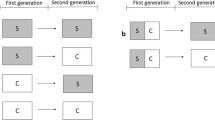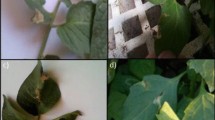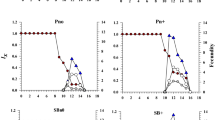Abstract
The study of the population dynamics of Helicoverpa armigera (Hübner) in Cicer arietinum (chickpea), Lycopersicon esculentum (tomato), Abelmeschus esculentus (okra) and Zea mays (maize) crops revealed that the insect passed through five overlapping generations in a year. The growth of the population of H. armigera and its generation survival were maximum in second generation followed by fourth, third, fifth and first generations. Parasitoids, predators, fungal and viral diseases and abiotic factors were among the various observed mortality factors, although the role of prédation was not specifically investigated. The key mortality factor within generation was an unidentified pupal parasitoid. The key mortality factor operating between generations was the variation in natality (log of ratio of maximum potential natality and actual eggs). In spite of the biotic mortality factors operating on H. armigera populations, the number of eggs laid is the most important factor that governs the trend of the population growth in all generations. Therefore, a powerful control measure is necessary by either trapping the adult moths or by cultivating trap crop to distract egg laying for those crops to be protected.
Résumé
L’étude de la dynamique de la population des Helicoverpa armigera (Hühner) sur les plantes de Cicer arietinum (pois chiche), de Lycopersicon esculentum (tomate), de VAbelmeschus esculentus (okra) et Zea mays (maïs) a révélé que l’insecte connaît cinq générations qui s’imbriquent les unes les autres tout au long de l’année.
L’accroissement démographique chez le Helicoverpa armigera et le taux de survie par génération atteignent leurs plus haut niveau à la seconde génération suivie dans l’ordre par la quatrième, la troisième, la cinquième et la première générations. Les parasites, les prédateurs, les maladies virales et celles dues aux champignons ainsi que des facteurs abiotiques étaient parmi les divers facteurs de mortalité observés, bien que le rôle spécifique de la prédation n’ait pas fait l’objet d’une même génération était un type de chrisalide parasite non identifié. Tandis que la principale cause de mortalité d’une génération à une autre était la variation dans le taux de natalité (proportion entre la potentialité maximale de natalité et les oeufs réelleement pondus).
En dépit des facteurs de mortalité biotiques actifs au sein de la population de H. armigera, la quantité d’oeufs pondus reste l’élément le plus important qui détermine l’évolution de l’accroissement de la population à travers toutes les générations.
D’où il importe de prendre des mesures solides de lutte soit en dressant des pièges aux phalènes adultes ou en insérant parmi les plantes à protéger des types de plantes dont la propriété est de détourner le dépôt des oeufs.
Similar content being viewed by others
References
Altieri M. A. and Liebman M. (1987) Insect, weed and plant disease management in multiple cropping systems. In Multiple Cropping Systems (Edited by Francis C. A.), pp. 183–218. New York, MacMillan.
Anonymous (1980) Sex is trap for Heliothis. Macquarie Irrig. Dep. Agric. (N. S. W.) 8, 5.
Bhatnagar V. S. and Davis J. C. (1980) Entomological studies in intercropped pigeon pea systems at ICRISAT Centre: Future developments and collaborative research needs. In Proceedings, International Workshop on Pigeon Pea, Vol. 2 ICRISAT/ ICAR, 15–19 Dec. 1980, Patancheru, A. P., India, pp. 341–347.
Bilapate G. G., Raodeo A. K. and Pawar V. M. (1979) Population dynamics of Heliothis armigera on gram. Indian J. Agric. Sci. 49, 560–566.
Bilapate G. G. (1981) Investigation on Heliothis armigera (Hübner) in Marathwada. XXIII. Key mortality factors on cotton, pigeon pea and chickpea. Proc. Indian Natl. Sci. Acad. Part B 47, 637–646.
Chaudhary J. P., Yadav L. S. and Peonia (1980) An integrated approach for the control of pod borer, Heliothis armigera (Hübner) on pigeon pea (Cajanus cajan Millsp.). Legume Res. 3, 59–65.
Davies J. C. and Bhatnagar V. S. (1976) Light trap summary of Heliothis armigera (Hübner) (1974-1976), Patancheru, India. Presented at All India Coordinated Pulse Improvement Programme Workshop, Varanasi (India) Sept. 27–30, 1976.
Dhandapani N. and Balasubramanian M. (1980) Life tables for the gram pod borer, Heliothis armigera (Hübner) on three pulse crops. Proc. Indian Acad, of Sci. (Animal Science 89, 575–578.
Duffey S. S. and Isman M. B. (1981) Inhibition of insect larval growth by phenolics in glandular trichomes of tomato leaves. Experientia 37, 574–576.
Elliger C. A., Wong Y., Chan B. G. and Waiss A. C. Jr. (1980) Growth inhibitors in tomato (Lycopersicon) to tomato fruitworm (Heliothis zea) J. Environ. Ecol. 67, 358–360.
Fitt G. P. (1989) The ecology of Heliothis species in relation to agroecosystem. Annu. Rev. Entomol. 34, 17–52.
Harcourt D. G. (1969) The development and use of life-tables in the study of natural insect populations. Annu. Rev. Entomol. 14, 175–196.
Hogg D. B. and Nordheim E. V. (1983) Age specific analysis of Heliothis spp. populations on cotton. Res. Popul. Ecol. 25, 280–297.
ICRISAT (1979) Pulse Entomology (Chickpea) Department Progress Report 4, Patancheru, A. P., India, Mimeographed*
Morris R. E. and Miller C. A. (1954) The development of life tables for spruce budworm. Can. J. Zool. 32, 283–301.
Reed W. and Pawar C. S. (1982) Heliothis: a global problem. Proc. Int. Workshop Heliothis Management, ICRISAT, Patancheru, India, 1981.
Rothschild G. H. (1978) Attractants for Heliothis armigera and Heliothis punctigera. J. Aust. Entomol. Soc. 17, 389–390.
Tripathi S. R. and Sharma S. K. (1987) Effect of different food plants on development, growth and reproduction of Heliothis armigera. Nigeria J. Entomol. 6, 33–38.
Author information
Authors and Affiliations
Rights and permissions
About this article
Cite this article
Tripathi, S.R., Singh, R. Population Dynamics of Helicoverpa Armigera (Hubner) (Lepidoptera: Noctuidae). Int J Trop Insect Sci 12, 367–374 (1991). https://doi.org/10.1017/S174275840001122X
Received:
Revised:
Published:
Issue Date:
DOI: https://doi.org/10.1017/S174275840001122X




